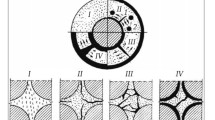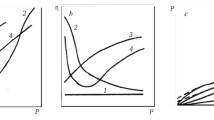Abstract
With allowance for the approach developed preferentially in the works of Tsimmermanis and Shtakel'berg, a set of fundamental regularities of the thermodynamics of irreversible processes (nonequilibrium thermodynamics) is used to analyze the processes of structure formation in manufacturing new refractory concretes. Structure formation and hardening of concretes is phenomenologically realized as the formation of a capillary-porous structure in the process of changes in the free surface energy of the system, which serves as a measure for the strength, elastic, and other properties of the material. In this approach to thermodynamic analysis of structure formation the watering potential of a disperse system is treated as an analog of the Gibbs chemical potential. The notions of structural affinity and the degree of completeness of structure formation are introduced by analogy with chemical affinity and the degree of completeness of a chemical reaction.
Similar content being viewed by others
References
Yu. E. Pivinskii, “Refractory concretes of a new generation. Colloidal-chemical aspect of technology,”Ogneupory, No. 1, 4 – 12 (1994).
Yu. E. Pivinskii, “Refractory concretes of a new generation. Rheological aspect of technology,”Ogneupory, No. 4, 4 – 15 (1994).
V. I. Babushkin, G. M. Matveev, and O. P. Mchedlov-Petrosyan,The Thermodynamics of Silicates [in Russian], Gosstroiizdat, Moscow (1962).
P. P. Budnikov and A. M. Ginstling,Reactions in Mixtures of Solid Substances [in Russian], Stroiizdat, Moscow (1971).
K. K. Strelov,Theoretical Foundations of the Technology of Refractory Materials [in Russian], Metallurgiya, Moscow (1985).
L. B. Khoroshavin,Magnesia Concretes [in Russian], Metallurgiya, Moscow (1990).
L. B. Tsimmermanis,Thermodynamic and Transfer Properties of Capillary-Porous Bodies [in Russian], Yuzhno-Ural'skoe Knizhnoe Izdatel'stvo, Chelyabinsk (1971).
L. B. Tsimmermanis and E. L. Vysochanskii (eds.),Thermodynamic Foundations of Intensification of Drying of Structural Materials and Parts [in Russian], UralNIIstromproekt, Chelyabinsk (1974).
D. I. Shtakel'berg,Thermodynamics of Structure Formation of Water-Silicate Disperse Materials [in Russian], Znanie, Riga (1984).
L. B. Tsimmermanis,Thermodynamics of the Humid Condition and Hardening of Structural Materials [in Russian], Znanie, Riga (1985).
L. B. Tsimmermanis, “Watering potential and phenomenological equations of transfer in capillary-porous bodies,” in: L. B. Tsimmermanis, et al. (eds.),Engineering Physics Investigations of Structural Materials [in Russian], UralNIIstromproekt, Chelyabinsk (1976), pp. 3–12.
L. B. Tsimmermanis, A. P. Genkin, and D. I. Shtakel'berg, “Thermodynamic analysis of hardening of the mineral binder in an open system,” in:Proc. of the VIth Internat. Congress on the Chemistry of Cements [in Russian], Vol. 2, Book 1, Stroiizdat, Moscow (1976), pp. 25–28.
M. N. Karapet'yants,Chemical Thermodynamics [in Russian], Khimiya, Moscow (1975).
I. Prigogine and R. Defay,Chemical Thermodynamics [Russian translation], Nauka, Novosibirsk (1966).
Yu. E. Pivinskii, “Refractory concretes of a new generation. Low-cement concretes, vibrocastable thixotropic refractory mixtures,”Ogneupory, No. 7, 1 – 10 (1990).
Yu. E. Pivinskii and M. A. Trubitsyn, “Refractory concretes of a new generation. Cementless concretes,”Ogneupory, No. 8, 6 – 16 (1990).
Yu. E. Pivinskii,Ceramic Binders and Ceramoconcretes [in Russian], Metallurgiya, Moscow (1990).
I. I. Prigogine,Introduction to the Thermodynamics of Irreversible Processes, Springfield (1955).
O. R. de Groot,Thermodynamics of Irreversible Processes [Russian translation], GITTL, Moscow (1956).
R. Haase,Thermodynamik der irreversiblen Prozesse, Darmstadt (1963).
N. Loopas,Chemical Thermodynamics of Materials [Russian translation], Metallurgiya, Moscow (1989).
Yu. G. Frolov and V. V. Belik,Physical Chemistry [in Russian], Khimiya, Moscow (1988).
A. V. Lykov,The Theory of Drying [in Russian], Energiya, Moscow (1968).
U. M. Raitburd and U. M. Oloninskaya, “Modern concepts of the clay minerals — cations — bound water system,” in:Bound Water in Disperse Systems [in Russian], Issue 1, Izd. MGU, Moscow (1970), pp. 78–101.
B. S. Sazhin,Fundamentals of the Drying Technique [in Russian], Khimiya, Moscow (1984).
Author information
Authors and Affiliations
Additional information
Translated from Ogneupory, No. 1, pp. 2–7, January, 1995.
Rights and permissions
About this article
Cite this article
Pivinskii, Y.E. Refractory concretes of a new generation. Thermodynamic aspect of the technology. Refractories 36, 3–8 (1995). https://doi.org/10.1007/BF02226978
Received:
Issue Date:
DOI: https://doi.org/10.1007/BF02226978




